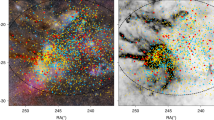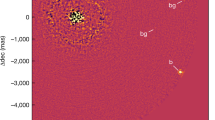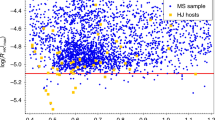Abstract
Most known extrasolar planets (exoplanets) have been discovered using the radial velocity1,2 or transit3 methods. Both are biased towards planets that are relatively close to their parent stars, and studies find that around 17–30% (refs 4, 5) of solar-like stars host a planet. Gravitational microlensing6,7,8,9, on the other hand, probes planets that are further away from their stars. Recently, a population of planets that are unbound or very far from their stars was discovered by microlensing10. These planets are at least as numerous as the stars in the Milky Way10. Here we report a statistical analysis of microlensing data (gathered in 2002–07) that reveals the fraction of bound planets 0.5–10 au (Sun–Earth distance) from their stars. We find that  of stars host Jupiter-mass planets (0.3–10 MJ, where MJ = 318 M⊕ and M⊕ is Earth’s mass). Cool Neptunes (10–30 M⊕) and super-Earths (5–10 M⊕) are even more common: their respective abundances per star are
of stars host Jupiter-mass planets (0.3–10 MJ, where MJ = 318 M⊕ and M⊕ is Earth’s mass). Cool Neptunes (10–30 M⊕) and super-Earths (5–10 M⊕) are even more common: their respective abundances per star are  and
and  . We conclude that stars are orbited by planets as a rule, rather than the exception.
. We conclude that stars are orbited by planets as a rule, rather than the exception.
This is a preview of subscription content, access via your institution
Access options
Subscribe to this journal
Receive 51 print issues and online access
$199.00 per year
only $3.90 per issue
Buy this article
- Purchase on Springer Link
- Instant access to full article PDF
Prices may be subject to local taxes which are calculated during checkout


Similar content being viewed by others
References
Mayor, M. & Queloz, D. A. Jupiter-mass companion to a solar-type star. Nature 378, 355–359 (1995)
Marcy, G. W. & Butler, R. P. A planetary companion to 70 Virginis. Astrophys. J. 464, L147–L151 (1996)
Charbonneau, D., Brown, T. M., Latham, D. W. & Mayor, M. Detection of planetary transits across a Sun-like star. Astrophys. J. 529, L45–L48 (2000)
Howard, A. et al. Planet occurrence within 0.25 AU of Solar-type stars from Kepler. Astrophys. J. (submitted); preprint at http://arxiv.org/abs/1103.2541 (2011)
Mayor, M. et al. The HARPS search for southern extra-solar planets XXXIV. Occurrence, mass distribution and orbital properties of super-Earths and Neptune-mass planets. Astron. Astrophys. (submitted); preprint at http://arxiv.org/abs/1109.2497 (2011)
Mao, S. & Paczynski, B. Gravitational microlensing by double stars and planetary systems. Astrophys. J. 374, L37–L40 (1991)
Gould, A. & Loeb, A. Discovering planetary systems through gravitational microlenses. Astrophys. J. 396, 104–114 (1992)
Bennett, D. P. & Rhie, S. H. Detecting Earth-mass planets with gravitational microlensing. Astrophys. J. 472, 660–664 (1996)
Wambsganss, J. Discovering Galactic planets by gravitational microlensing: magnification patterns and light curves. Mon. Not. R. Astron. Soc. 284, 172–188 (1997)
Sumi, T. et al. Unbound or distant planetary mass population detected by gravitational microlensing. Nature 473, 349–352 (2011)
Udalski, A. The Optical Gravitational Lensing Experiment. Real time data analysis systems in the OGLE-III survey. Acta Astronaut. 53, 291–305 (2003)
Bond, I. A. et al. Real-time difference imaging analysis of MOA Galactic bulge observations during 2000. Mon. Not. R. Astron. Soc. 327, 868–880 (2001)
Albrow, M. et al. The 1995 pilot campaign of PLANET: searching for microlensing anomalies through precise, rapid, round-the-clock monitoring. Astrophys. J. 509, 687–702 (1998)
Gould, A. et al. Microlens OGLE-2005-BLG-169 implies that cool Neptune-like planets are common. Astrophys. J. 644, L37–L40 (2006)
Gaudi, B. S. et al. Discovery of a Jupiter/Saturn analog with gravitational microlensing. Science 319, 927–930 (2008)
Udalski, A. et al. A Jovian-mass planet in microlensing event OGLE-2005-BLG-071. Astrophys. J. 628, L109–L112 (2005)
Dong, S. et al. OGLE-2005-BLG-071Lb, the most massive M dwarf planetary companion? Astrophys. J. 695, 970–987 (2009)
Gould, A. et al. Frequency of solar-like systems and of ice and gas giants beyond the snow line from high-magnification microlensing events in 2005–2008. Astrophys. J. 720, 1073–1089 (2010)
Beaulieu, J.-P. et al. Discovery of a cool planet of 5.5 Earth masses through gravitational microlensing. Nature 439, 437–440 (2006)
Kubas, D. et al. Limits on additional planetary companions to OGLE 2005-BLG-390L. Astron. Astrophys. 483, 317–324 (2008)
Gaudi, B. S. et al. Microlensing constraints on the frequency of Jupiter-mass companions: analysis of 5 years of PLANET photometry. Astrophys. J. 566, 463–499 (2002)
Einstein, A. Lens-like action of a star by the deviation of light in the gravitational field. Science 84, 506–507 (1936)
Dominik, M. Stochastic distributions of lens and source properties for observed galactic microlensing events. Mon. Not. R. Astron. Soc. 367, 669–692 (2006)
Cassan, A. An alternative parameterisation for binary-lens caustic-crossing events. Astron. Astrophys. 491, 587–595 (2008)
Sumi, T. et al. A cold Neptune-mass planet OGLE-2007-BLG-368Lb: cold Neptunes are common. Astrophys. J. 710, 1641–1653 (2010)
Howard, A. W. et al. The occurrence and mass distribution of close-in super-Earths, Neptunes, and Jupiters. Science 330, 653–655 (2010)
Cumming, A. et al. The Keck Planet Search: Detectability and the minimum mass and orbital period distribution of extrasolar planets. Publ. Astron. Soc. Pacif. 120, 531–554 (2008)
Pollack, J. B. et al. Formation of the giant planets by concurrent accretion of solids and gas. Icarus 124, 62–85 (1996)
Tsapras, Y. et al. Microlensing limits on numbers and orbits of extrasolar planets from the 1998–2000 OGLE events. Mon. Not. R. Astron. Soc. 343, 1131–1144 (2003)
Snodgrass, C. et al. The abundance of Galactic planets from OGLE-III 2002 microlensing data. Mon. Not. R. Astron. Soc. 351, 967–975 (2004)
Acknowledgements
Support for the PLANET project was provided by the HOLMES grant from the French Agence Nationale de la Recherche (ANR), the French National Centre for Scientific Research (CNRS), NASA, the US National Science Foundation, the Lawrence Livermore National Laboratory/National Nuclear Security Administration/Department of Energy, the French National Programme of Planetology, the Program of International Cooperation in Science France–Australia, D. Warren, the German Research Foundation, the Instrument Center for Danish Astronomy and the Danish Natural Science Research Council. The OGLE collaboration is grateful for funding from the European Research Council Advanced Grants Program. K.Ho. acknowledges support from the Qatar National Research Fund. M.D. is a Royal Society University Research Fellow.
Author information
Authors and Affiliations
Contributions
A.Ca. led the analysis and conducted the modelling and statistical analyses. A.Ca. and D.K. selected light curves from 2002–07 PLANET/OGLE microlensing seasons, analysed the data and wrote the Letter and Supplement. D.K. computed the magnification maps used for the detection-efficiency calculations. J.-P.B. and Ch.C. wrote the software for online data reduction at the telescopes. J.-P.B. led the PLANET collaboration, with M.D., J.G., J.M. and A.W.; P.F. and M.D.A. contributed to online and offline data reduction. M.D. contributed to the conversion of the detection efficiencies to physical parameter space and developed the PLANET real-time display system with A.W., M.D.A. and Ch.C.; K.Ho. and A.Ca. developed and tested the Bayesian formulation for fitting the two-parameter power-law mass function. J.G. edited the manuscript, conducted the main data cleaning and managed telescope operations at Mount Canopus (1 m) in Hobart. J.W. wrote the original magnification maps software, discussed the main implications and edited the manuscript. J.M., A.W. and U.G.J. respectively managed telescope operations in South Africa (South African Astronomical Observatory 1 m), Australia (Perth 0.61 m) and La Silla (Danish 1.54 m). A.U. led the OGLE campaign and provided the final OGLE photometry. D.P.B, V.B., S.B., J.A.R.C., A.Co., K.H.C., S.D., D.D.P., J.D., P.F., K.Hi., N.K., S.K., J.-B.M., R.M., K.R.P., K.C.S., C.V., D.W., B.W. and M.Z. were involved in the PLANET observing strategy and/or PLANET data acquisition, reduction, real-time analysis and/or commented on the manuscript. T.S. commented on the manuscript. M.K.S., M.K., R.P., I.S., K.U., G.P. and Ł.W. contributed to OGLE data.
Corresponding authors
Ethics declarations
Competing interests
The authors declare no competing financial interests.
Supplementary information
Supplementary Information
The file contains Supplementary Text and Data, Supplementary Figures 1-5 with legends, Supplementary Table 1 and additional references. (PDF 692 kb)
PowerPoint slides
Rights and permissions
About this article
Cite this article
Cassan, A., Kubas, D., Beaulieu, JP. et al. One or more bound planets per Milky Way star from microlensing observations. Nature 481, 167–169 (2012). https://doi.org/10.1038/nature10684
Received:
Accepted:
Published:
Issue Date:
DOI: https://doi.org/10.1038/nature10684
This article is cited by
-
Habitability and sub glacial liquid water on planets of M-dwarf stars
Nature Communications (2023)
-
Atmospheric characterization of terrestrial exoplanets in the mid-infrared: biosignatures, habitability, and diversity
Experimental Astronomy (2022)
-
Identifying molecules as biosignatures with assembly theory and mass spectrometry
Nature Communications (2021)
-
Microlensing mass measurement from images of rotating gravitational arcs
Nature Astronomy (2021)
-
Tidal fragmentation as the origin of 1I/2017 U1 (‘Oumuamua)
Nature Astronomy (2020)
Comments
By submitting a comment you agree to abide by our Terms and Community Guidelines. If you find something abusive or that does not comply with our terms or guidelines please flag it as inappropriate.



